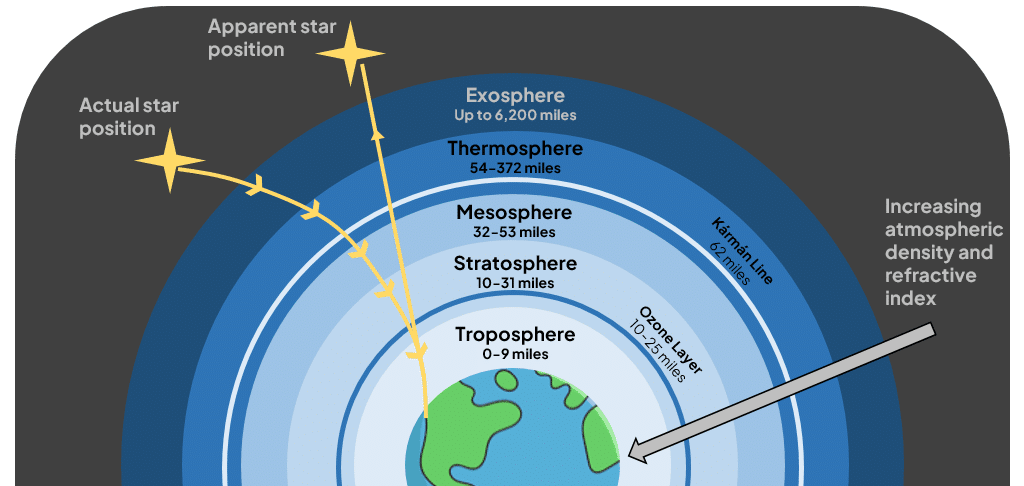You’ve heard the song Twinkle Twinkle Little Star, but is it true?
When you look into the night sky, the starlight above flickers. Set up a quick test to explore what happens to light as it travels from a star to Earth.
Catch the video below to see a walk through of this activity and hear a scientifically accurate version of Twinkle Twinkle Little Star!
Materials
Tin foil
Flashlight
Pen
Glass bowl
Water
Dark room
Activity Instructions
Create a Star
Cut a piece of tin foil that is larger than your flashlight. Carefully poke small holes in the tin foil with the tip of the pen.
Cover the front of your flashlight with the tinfoil, making sure the light shines through several of the holes.

Create Earth’s Atmosphere
Fill a glass bowl most of the way with water.

Create a Night Environment
Place the flashlight on the table about 1 ft away from the bowl. Turn on the flashlight and turn off the room lights.
Tap the bowl, moving the water slightly. Observe the light as it travels from the flashlight, through the water, and out the other side of the bowl.
You might want to place the flashlight on a book to make sure light can be observed on the other side of the bowl.

What did you observe?
Let’s Think…
Do you think stars really twinkle? Why or why not?
Why do you think we need to move the water for our experiment to work?
How is the bowl of water similar to Earth’s atmosphere?
What was the most surprising thing about this activity?
What’s the Science?
When light leaves a star, the light is not moving. However, when we look up at the night sky from Earth, that same starlight seems to twinkle. The illusion of moving light occurs because of these three things:
First, star light bends as it moves through the layers of Earth’s atmosphere.
Earth’s atmosphere is made of 5 layers. The outer most layer is called the Exosphere and the air there is very thin. As you get closer and closer to Earth’s surface, the atmosphere becomes more and more dense.

When light travels from one substance to another it bends. This is called refraction. Each time starlight moves into a new layer of Earth’s atmosphere, it bends. By the time light from a distant star travels all the way from outer space to Earth’s surface, it has been refracted many times. So much so that the place we THINK we see the star is not the real position of the star!
Try This! Place a pencil in a clear glass of water. When you look at the glass from the side, what do you notice? The pencil appears broken because of refraction. Light is bending differently as it travels through the water, which is denser than the air, making the pencil look disconnected.
Second, stars are very far away from Earth.
Stars are huge, but they are so far away that we only see a little speck of light in the sky. This is true even when we look at stars through a telescope!
The effect of light refraction is much larger on a small amount of light than a big source of light. Planets, which are generally smaller than stars but much closer to Earth, do not appear to twinkle because the larger amount of light is not as visually effected by refraction. If stars were closer, they would not twinkle!
Third, Earth’s atmosphere is always moving.
In our experiment, we needed to tap our bowl of water to observe twinkling light. Earth’s atmosphere does the same thing! Air in our atmosphere is always moving and shifting, causing the distant starlight to appear to move even more than with refraction alone.
So is Twinkle Twinkle Little Star right or wrong?
To humans on Earth, stars do twinkle! But they twinkle as a result of their distance, light refraction, and Earth’s moving atmosphere. The starlight, when viewed in space, does not twinkle.
More Ideas
Still curious? Check out these additional resources to continue your adventure!
How Big is a Star?
Watch this animation to see how Earth compares to VY Canis Majoris, one of the largest known stars.
Light from Space is a Time Machine
It takes sunlight 8 seconds to reach Earth. Discover how long it takes light to reach Earth from other space-objects.
Explore All!
Check out all of OMSI’s Science at Home videos and experiments.
Thanks to Our Sponsors
This project is made possible by a grant from the Marie Lamfrom Charitable Foundation.
